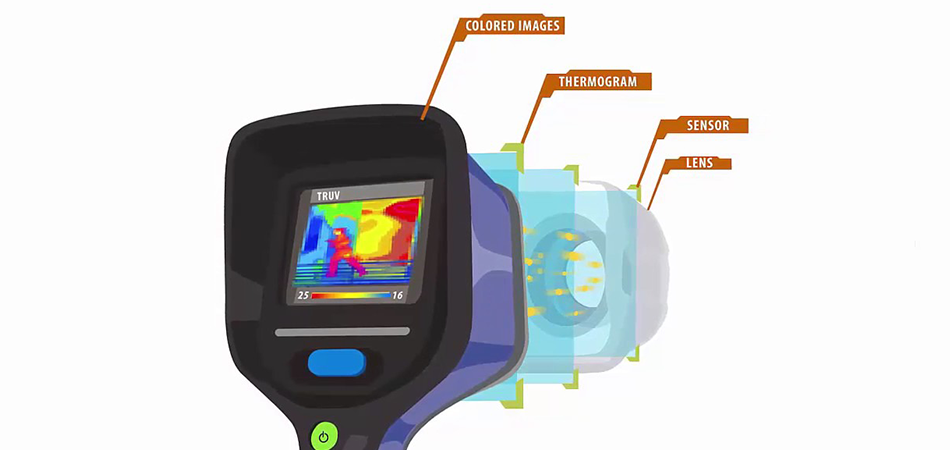All living things and objects alike emit wavelengths of infrared radiation. The thermal imagers or cameras are designed in a manner that they can detect all forms of detected radiation. These devices capture infrared radiations of different levels, which will help to tell the object’s temperature in the subject.
Human beings cannot see infrared light with their eyes so they use special infrared goggles. The thermal cameras are used in different fields of study to detect heat and an object’s temperature. This is displayed on the screen for further interpretation at large. In this post, I will cover what the thermography colors mean and how the thermal cameras work. Let’s start to learn thermal camera colors meaning.
What do the Colors Mean on a Thermal Camera?
Thermal cameras represent what they capture in the form of a thermogram. The thermograms are in the way of false colors that will display on the screen for further interpretation. The information displayed on the screen relates to the heat a particular object in the subject emits. High temperatures are represented by brighter colors and low temperatures with dark colors as such. Let’s learn deeper about thermal camera colors meaning.
Various colors are employed in the interpretation of the temperature or amount of heat an object emits. The colors range from red, orange, black, yellow, and purple. Brighter colors, in this case, like red, yellow, and orange are the brighter options. They are used to represent warmer temperatures. The purple, dark blue, and black, on the other hand, represent low temperatures at large.
High temperatures are a result of the emission of more infrared radiation. On the other hand, low temperatures mean low infrared radiation emission. Darker colors, dark blue, black, and purple represents a temperature of around zero degrees Celsius. So, if the color displayed gets darker, then the temperatures are likewise approaching zero degrees Celsius.
When the colors start appearing brighter and brighter, then there is probably an increase in temperature. The mild yellow and red represent a temperature rise up to 23.5˚C These colors are employed to signify mild temperatures. When the temperature rises to a point even beyond 62.3˚C, orange and yellow colors present this temperature range.
When interpreting or trying to read thermography colors, there is one thing you should have in mind. The brighter colors in a thermogram represent a temperature rise. The darker colors represent temperatures approaching zero degrees Celsius. Bright color means more infrared radiation emission, while dark means low emission of infrared radiation. We can summarize this information as;
- Red and Yellow: Represents mild temperature.
- Orange: Represents high temperature.
- Dark blue, Black, and Purple: Represents temperatures close to zero degrees Celsius.
Once you grasp what the colors mean, reading, and interpreting the thermal camera, results will be easy. Practice and memorize them to ensure you make an informed decision from the outcomes.
How Does a Thermal Camera Work?
Thermal cameras are modern non-contact gadgets. Thay detect heat from an object and converts it into something visual we can easily read and interpret. Let’s chip in into the idea about how these cameras work.
Before we learn how they work, it is essential to know that they don’t function like regular cameras. The regular camera and the human eye use the same principle to function; they use visible energy to work. Visible light energy will bounce off after hitting an object. Details are transferred to the detector where they will be converted into a visual image.
This is different from thermal cameras since they use heat emitted from an object to form an image. Both light and heat are found in the electromagnetic spectrum. However, regular cameras can only detect visible light, and they won’t see any form of thermal energy. On the other hand, the thermal cameras can detect thermal energy, and they won’t see the visible light. Before we get a blueprint about this topic, let’s know what is inside the thermal camera.
These cameras have the lens, processing units or electronics, a thermal sensor, and mechanical housing. Sensors of various thermal cameras in the market come with different pixel configurations. This is the resolution of the camera.
The resolutions of the thermal cameras are low compared to what regular cameras have. This is because the thermal cameras are employed to detect heat energy with larger wavelengths. For this reason, there is a need for each sensor to be of significant size to work correctly. So, how do these devices work?
The thermal cameras function with a combination of circuits and sensors. They convert absorbed radiations to form visual images that are displayed on the screen. The thermal camera absorbs infrared rays in the entire area it focuses. There are phased arrays of detectors in the device that scans the focused light.
It is at the detector where precise temperature patterns are created. These are known as the thermograms, and it takes just a split of a second to create them. The information that is processed in the thermal camera is what is in the range of the lens field of view.
The temperature patterns or thermogram gets converted to electric impulses. They pass to the circuit board designed with a chip that converts electrical impulses into usable data.
Translated data is passed to the signal processing unit that later transfers the information to the thermal camera screen. The result is an image of different colors that will be interpreted further.
Final Word
We have grasped all information about the thermal camera colors meaning. Besides, we have learned how thermal cameras work. This information allows users to make greater use of the thermal cameras they have. The thermal cameras are easy to operate and are employed in several fields to detect problems to fix them early before they grow big.


